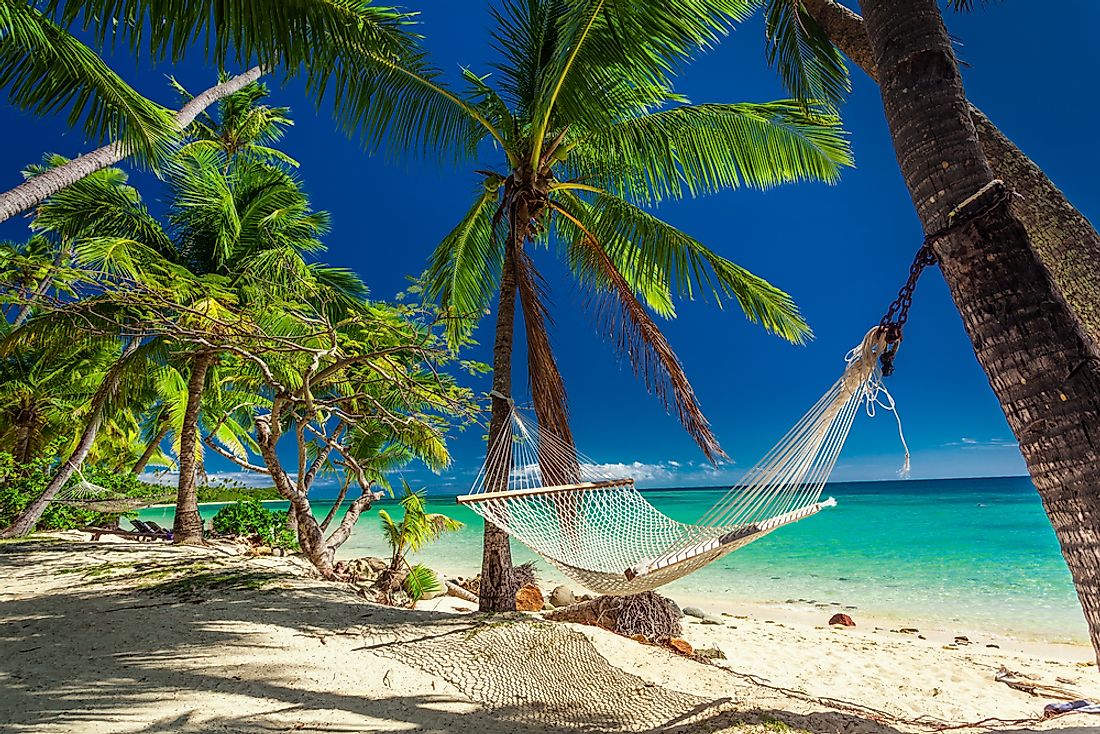What Are the Biggest Industries in Fiji?

Fiji is a nation composed of more than 300 islands in the Pacific Ocean and occupies an area of 7,056 square miles. In 2017, Fiji had a gross domestic product (GDP) of approximately $5 billion, which represented an increase of $0.39 billion from the previous year. The Asian Development Bank expects Fiji's GDP to grow by 3.6% in 2018. More than 98% of the nearly 905,000 people who live in Fiji have access to electricity, but data from the Asian Development Bank indicates that close to 30% of the country's citizens live below the poverty line. The national currency is the Fijian dollar, although the American dollar is commonly accepted throughout the country. Fiji is ranked 97th in terms of the ease of doing business.
Tourism
Tourism is an essential industry to the Fijian economy, as it generated more than $250 million in the third quarter of 2017 alone. More than 40,000 people are employed either directly or indirectly through tourism. The growth of Fiji's tourism sector is mainly the result of efforts from the private sector, while the government is responsible for marketing Fiji abroad through the Department of Tourism, which is part of the Ministry of Industry and Trade. The nation's beautiful scenery draws visitors to the country, including the Beqa lagoon, which is a popular spot for couples on their honeymoon. Most of Fiji's tourists come from three nations: Australia, New Zealand, and America. Fiji has invested in a variety of five-star resorts that cater to wealthy clientele, as well as more budget-friendly accommodations, which have contributed significantly to the increasing number of tourists. In order to boost the number of visitors, Fiji gives visas to citizens of specific nations upon arrival instead of requiring them to get a visa in advance. The tourism sector in Fiji is susceptible to changes in international markets, as the 2008 financial crisis resulted in a decrease in the number of visitors.
Agriculture
Agriculture was once the central pillar of the Fijian economy, but has since been surpassed by tourism. Most farming in Fiji is commercial, and sugarcane, coconuts, and pineapples serve as the primary crops. At one point, sugarcane was the main crop grown in Fiji, however, the decline in the international price of Fiji's sugar has affected the revenue of a large number of farmers. The European Union was once a significant buyer of Fiji's sugar, but since it dropped preferential prices for Fiji's sugar, the sector has been widely affected. In spite of all the challenges facing the sugar sector, it still provided employment to more than 200,000 people in 2017. The government has diversified the agricultural sector by encouraging farmers to plant a wide array of crops, particularly with the tourist market in mind. Natural disasters, such as floods and tropical cyclones, usually hurt Fiji's agricultural communities. The government has create tax incentives to stimulate the growth of the farming sector, and farmers also benefit from government subsidies on a wide range of agricultural implements such as chemicals, fertilizers, and feeds. Livestock such as goats, pigs, and sheep are also kept in the country. The Fiji Development Bank offers loans to people involved in the livestock sector to stimulate growth in the industry. Livestock farmers who keep goats, sheep, and cattle formed the Fiji Grazing Livestock Association to represent them and voice their demands. Data from the association indicates that the dairy industry that produces an annual average of 13 million liters of milk is only 20% self-sufficient.
Mining
Fiji has an abundance of high-value mineral resources, such as gold, that contribute significantly to the national economy. Gold has been a critical mineral export for Fiji for more than 70 years, as investors and prospectors are attracted to the high prices. Fiji's location makes it a prime spot for the prospecting of minerals, attracting large numbers of foreign investors. Baron de Este was among the first individuals to discover gold in Fiji in 1872 within the Nasivi River. Historically, the leading gold mining region in Fiji was the Vatukoula region, but the mine has been closed due to high operation costs and the low value of gold, which resulted in low returns for the companies in charge of the mine. When the mine closed, nearly 2,000 people lost their jobs, which had a negative impact on the country's economy. In 2008 the mine reopened and started producing gold on a small scale. Environmental conservation has been a significant issue, as waste from the mining process is dumped into the sea. Mining companies in Fiji are taking a more environmentally conscious stand to ensure sustainability of the industry. The government of Fiji has put in place several measures to attract investment in the sector.
Challenges Facing Fiji's Economy
The Fijian economy faces a diverse range of problems ranging from insecurity to complicated property laws. The country's security situation has been precarious, mainly due to two military coups against the state. This instability discouraged investment in Fiji, leading to sluggish growth in the economy. The security crisis has also led to the migration of skilled workers out of the country. Fiji ranks among the top five states that are losing skilled workers. Most land in Fiji is owned by the indigenous communities, and the land is then leased to individuals and organizations who wish to use it. The system has proven complicated, particularly when it comes to agricultural land. The island nation is also very susceptible to natural disasters that devastate its economy and cause food shortages. Pollution of the water supply is a common occurrence and leads to outbreaks of diseases. Fiji has a homelessness crisis which affected close to 10% of the country's population in 2003. This crisis has been blamed on various factors, including the collapse of traditional family structures.











